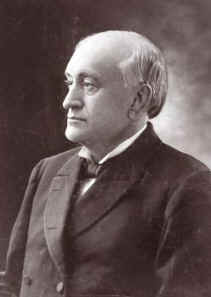 Phineas
Bresee began his pastoral career as the minister of First Methodist Church
in Los Angeles. He assumed responsibilities as the director of Penial
Missions within the church. Phineas
Bresee began his pastoral career as the minister of First Methodist Church
in Los Angeles. He assumed responsibilities as the director of Penial
Missions within the church.
With the arrival of the Holiness Movement, Bresee began to feel a sense of doubt and dissatisfaction while in the Methodist Church. He questioned whether Methodism had helped him to answer the questions of destiny and God. From this doubt, Bresee decided to build a system of beliefs based on Faith, Revelation, Atonement, New Birth, and Destiny that would answer his questions and develop his personal Christian beliefs. Bresee assured himself that these beliefs were true, and with this new system of beliefs, he sought a renewed religious experience with God. Soon he became Baptized in the Holy Spirit which "took away his tendencies to worldliness, anger, and pride" as well as doubt (Smith, 94). Not long thereafter, Bresee became the director of the mission for Penial Church. In this role, he sought a plan that would allow him to minister to all people, regardless of their religious denomination. He wanted people to make the Penial Mission and the First Methodist Church their Christian home. Many Methodist clergy did not agree with integration of their traditional Methodist Church. They objected to ministering to poor, and non-Methodists. Bresee did not want to deprive the poor of church membership because he believed that his purpose as a minister was to help sanctify all members of the community, including the poor. Bresee refused to alter his integration plans, which resulted in high tensions with the Methodist authorities. He soon found himself "frozen out" or excluded from the church missionary work (Smith, 109). At this point, Bresee realized that the only way he could pursue his calling from God and minister to the misfortunate was to create his own church. Bresee created the Church of the Nazarene based strongly on Methodist fundamentals. The development of the Church of the Nazarene revealed "a trend away from interdenominational associations toward a more denominational understanding of the [Holiness] movement, and away from extreme congregationalism toward a connectional conception of the church that owed much to Methodism" (Ahlstrom, 819).The church became glorified in the fact that it was free to all men and in that the members received a "second blessing" after they became sanctified (Ahlstrom, 819). The Church of the Nazarene has undergone a few changes since its beginning. In 1885 after being separated for the First Methodist Church and Penial Mission for a year, Bresee formed the First Church of the Nazarene in Los Angeles, California. In 1907, the Association of Pentecostal Churches of America and the Church of the Nazarene joined to form the Pentecostal Church of the Nazarene. On October 13, 1908, the Holiness Church of Christ united with the Pentecostal Church of the Nazarene which signifies the official founding of the Church of the Nazarene. In 1919, the term "Pentecostal" was dropped from the church name to separate the church from those sects that accepted "speaking in tongues" (Melton, 345).
|